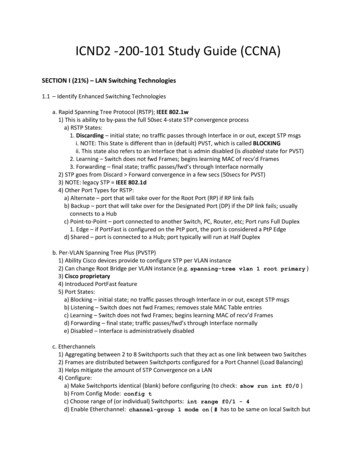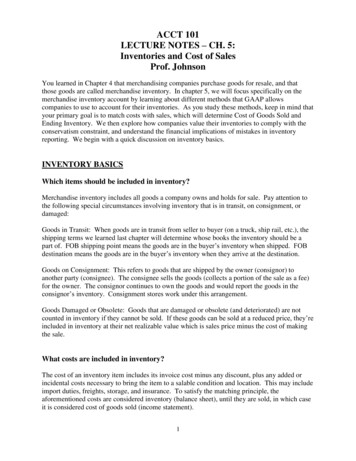
Transcription
BITCOINS BASICS101DAVID DODGE&BRIAN DIXONAdditional Content on the website:Bitcoinbasics101.com1
TABLE OF CONTENTS:The Birth and Evolution of Bitcoin3CHAPTER 1:General Information You Should Know about Bitcoin5What is Bitcoin?5Bitcoin Exclusives5How Does Bitcoin Work?7The Basics You Need to Understand7How to Obtain Bitcoin8Step One: Get a Bitcoin Wallet8Bitcoin Exchanges9Face to Face / Over the Counter Trades10Bitcoin Mining11Bitcoin investment trust12Bitcoin ATMs12Acquiring Bitcoins Not Super Easy12Bitcoin Rewards14CHAPTER 2:Bitcoin and the Economy16What is The Value Of Bitcoin17Bitcoin Deflation And Economic Activity20Bitcoin Strengths and Weaknesses24CHAPTER 3:Advice and Tips for Bitcoin28Conclusion30Glossary312
INTRODUCTIONTHE BIRTH AND EVOLUTION OF BITCOINThe idea of Bitcoin was created by an anonymous programmer who goes by the name“Satoshi Nakamoto.” The idea came to this person back in 2008, when the world economy waslooking at a major recession. Satoshi first registered the bitcoin.org domain name then wenton to release a paper about Bitcoin in October of 2008. They wanted to come up with a newcurrency that held onto the good points of previous currencies - divisibility, portability,durability, uniformity, quality and scarcity.The paper Satoshi published in 2008 described a mathematical problem with 21 millionpossible solutions. This finite number of solutions fit well with his idea of making Bitcoin scarce- just like real money. Even though bitcoins had no value when they were first released, hehoped this would change over time as more people became involved. Satoshi registered theproject for Bitcoin at SourceForge.net on November 9, 2008, deciding to keep the code opensource. This helps by allowing others to view and study the code, even making their owncontributions. Strict controls were put in place to make sure everyone is on the same pagewhen it comes to the direction the software behind Bitcoin is moving.By January 9, 2009, Bitcoin v0.1 was released and announced on a cryptography mailing listonline. A lot of people noticed, but Bitcoin didn't really take off quickly. For over eight months,work on the code continued but the problem of bitcoins not having any value continued. Then,in October of 2009, exchange rates for bitcoins were published by New Liberty Standard.They listed the value at 1,309.03 BTC 1 USD. While many people laughed at the idea ofstarting a new currency, the fact that bitcoins now had value changed everything. The Bitcoinpeer to peer network was up and running. And due to the fact that only a certain number ofBitcoins were created, this gave the new currency scarcity, which helped it tremendously.On December 16, 2009, Bitcoin v0.2 was released to the world. The main users of Bitcoin atthis time were computer programmers, but they actually began to trade BTC back and forth formoney and services. By January of 2010, the first Bitcoin Exchange was established online,allowing people to buy, trade and sell BTC in a marketplace. By July of that year, MtGox, whatwould become one of the largest BTC marketplaces, was launched.Over the next three years, Bitcoin would become even more popular, reaching manymilestones along the way. From the first pizza bought with BTC to it finally reaching parity withthe US dollar on February 9, 2011. Slashdot also took notice of Bitcoin in February of 2011,causing the Bitcoin.org website to crash due to the number of people checking out thewebsite. Over 5 million BTC had been created by this time, but it was still well under the 21million to be created.3
Many new marketplaces opened in 2011 and 2012 as more and more people began to find outabout Bitcoin. While it had started as a tech curiosity for programmers, Bitcoin was slowly butsurely attracting all types of people. And as the media coverage of Bitcoin continued, thenumber of people interested also rose considerably. On June 2, 2011, the exchange rate forbitcoins reached 10 USD per BTC, an unheard of level up to that point. Some speculated thatthe value would hold around 10, but this wasn't the case as bitcoins became even morepopular - and valuable.As the value of bitcoins increased, criminals also started to take interest. On March 1, 2012, alarge theft of bitcoins occurred. Close to 50,000 BTC were pilfered after a security breach atthe web host Linode. This furthered the idea that bitcoins had value and made them morevaluable. Unfortunately, this wouldn't be the only theft of BTC during its lifetime, but it was thelargest up to that point, and one that made a lot of people notice Bitcoin for the first time.In September of 2012, the Bitcoin Foundation was set- up. A lot of Bitcoin conferences hadtaken place over the previous two years, but the Bitcoin Foundation was formed tostandardize, protect and promote Bitcoin worldwide. This is now the organization that votes tomake major decisions about the future of Bitcoin around the world. Keep reading as we take alook at how you can get involved with Bitcoin as well as what the future holds forcryptocurrency around the world.4
CHAPTER 1GENERAL INFORMATION YOU SHOULD KNOW ABOUT BITCOINWHAT IS BITCOIN?Bitcoin is called virtual currency, but a better term is cryptocurrency. Unlike physical money,there are no coins or paper money officially produced. No government entity decides howmuch and when to release it into the world. Bitcoins are created digitally by people as theysolve complex math problems with their computers. In many senses, it is truly decentralized.One of the interesting things about this virtual currency is that all transactions are stored andpublished publicly. The currency is traded via a vast peer- to- peer network that encompassesthe entire globe. While there aren't a lot of rules regarding Bitcoin, there are some, and thishelps with making bitcoins a genuine currency that works like "normal money."BITCOIN EXCLUSIVESNext, we're going to take a look at some of the ways that Bitcoin is different than traditionalcurrencies. It's these differences that make Bitcoin such a powerful possibility. One of themain differences is that Bitcoin is decentralized. No one person, corporation or governmentcontrols the Bitcoin network. This isn't the only difference, however, so let's take a look atsome things that are exclusive to Bitcoin.Bitcoin vs. Conventional currencies1. Bitcoin is DecentralizedUnlike traditional currency, which is controlled by a central authority - usually an arm of thegovernment - Bitcoin is decentralized. Because it operates as a peer- to- peer network, alltransactions and verification of transactions are done by various people in the network.2. Bitcoin is Virtual CurrencyThe other thing that sets Bitcoin apart from traditional currency is the fact that it's virtual. Thatis to say coins and paper money aren't produced to represent the value. Instead, all bitcoinsexist in virtual space. This means you can't go to an ATM and withdraw physical money. Somepeople have created unofficial physical representations of bitcoins, but first and foremost,Bitcoin is virtual.5
3. Bitcoin has ScarcityBecause only 21 million bitcoins will be created, BTC has scarcity, unlike traditional currencythat can be printed when governments decide to print more. To spread out the creation ofbitcoins being released into the world, the number that are created by "mining" will half everyfour years. This means that people will still be able to create them until the year 2140. At thattime, no new bitcoins will be created and the existing stockpile will enjoy the benefits ofscarcity - i.e. becoming more valuable.5. Bitcoin transactions cannot be reversedIn order to preserve the block chain of all transactions in sequential order, Bitcoin transactionsare not reversible. Additionally, a Bitcoin transaction can take ten minutes or more to confirm.This is different than other currencies that typically process transactions in seconds and alsoallow for reversing a charge to a credit or debit card.6. Bitcoin is not UbiquitousWherever you go in the world, you're going to run into local currencies. In most places, you'llbe able to trade your country's money for bills of the country you're visiting. And no matterwhere you go in the world, you're going to be able to trade your money for goods andservices. Bitcoin hasn't yet been embraced by the world at large. This may change in years tocome as more businesses begin to accept Bitcoin for payment, but for now it's a differencethat matters to a lot of people.Good and Bad of BitcoinAs you can see from the points above, Bitcoin has a lot of positives and negatives attached toit currently. Because it's decentralized and generally has low fees for transactions, manypeople are starting to take notice and get excited about this and other cryptocurrencies.Another thing to note is that some people worry about who controls the Bitcoin network. Thereality is that because it uses peer- to- peer technology, no one person or corporation can ownthe Bitcoin network. This may seem scary to some while it's revolutionary and exciting toothers.The need for all versions of Bitcoin software to be compatible and be able to communicate witheach other is paramount to Bitcoin's success. Luckily, most people who are involved realizethis and have worked together to improve the Bitcoin software and network considerably in justa few short years.6
The fact that Bitcoin is different than anything else that was around when it first came out isboth good and bad, but at the end of the day it makes Bitcoin unique and special. And this justmight be what's able to help Bitcoin grow even more quickly around the world. This may turnout to be the financial system that brings the world together.HOW DOES BITCOIN WORK?The Basics You Need to UnderstandLet's start by looking at the different things you need to get a cryptocurrency working. We'llstart with the basics and then move into more specifics about what you'll need to get started. The Transaction - The first thing you need to think about with a virtual currency is thetransaction - the actual exchange of value from one person to another. While this maysound simple, in many ways it can be easy to forge a transaction to try to cheat thesystem. With physical currency, transactions are controlled by banking institutionswhich verify that they're not forged and are unique. A Serial Number - To avoid people trying to forge transactions or reuse them withvirtual currency, you need a way to tie a unique serial number to each person andeach transaction as well. Bitcoin does this by using a private and public encrypted key.These hashes are used to make sure transactions aren't duplicated in the network andthere's no way to cheat the system. Goodbye Banks - Currently, banks are in place to facilitate a financial transactionbetween two people. When Bitcoin was being set- up, it was realized that banks couldbe taken out of the pict
101 DAVID DODGE & BRIAN DIXON Additional Content on the website: Bitcoinbasics101.com 1. TABLE OF CONTENTS: The Birth and Evolution of Bitcoin 3 CHAPTER 1: General Information You Should Know about Bitcoin 5 What is Bitcoin? 5 Bitcoin Exclusives 5 How Does Bitcoin Work? 7 The Basics You Need to Understand 7 How to Obtain Bitcoin 8 Step One: Get a Bitcoin Wallet 8 Bitcoin Exchanges 9 Face











